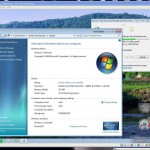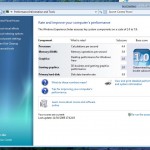I blogged a few days back saying I was trying Ubuntu full-screen in Sun’s VirtualBox to see if I could use it to replace Windows. The answer then was yes, pretty much. I also found a spare 160GB SATA disk, so decided to install a fresh Ubuntu 9.10 image on that and leave Windows alone for a week or so.
Yep, that works as well. No issues, could do everything I wanted except Lord of the Rings Online (probably works in WINE but why bother when I have an XP license). But.
But there wasn’t any real driver for me to keep using Ubuntu. I don’t have to give up XP (yet), after all, I paid for this license (kind of) and I can already do everything I want under XP, and use a lot of Open Source software to achieve that. So, after being logged in to Ubuntu for a week, and fancying a quick bash on Lord of the Rings Online I rebooted back to Windows XP and realised I felt like I’d made it back home after a luxury holiday somewhere exotic. Sure it was nice, but also, nice to be home.
Don’t get me wrong, I love Linux, I love UNIX and I can only get by day-to-day because I have Cygwin installed and can grep and awk and finger as much as I like. But I don’t need to be using Ubuntu all day to get things done. Maybe in a few years when I want to give up Microsoft products and stop paying their tax, but for now, no pressure.
So, here I am back in Windows. But I miss some stuff Ubuntu, and in the short time I used Evolution and a few other things, I came to like them. No problem I thought, let’s try coLinux again. Surely, in 10 minutes, I can whip together a coLinux Ubuntu distribution, and be using XWindows and Gnome.
Well, not quite. I followed most of this excellent guide to build a basic Ubuntu 9.10 coLinux image. Really, it’s superb. I tried booting it into coLinux – but no joy. I hung half way through the boot. An hour or so later and I discovered it was because Ubuntu Karmic requires some kernel features not present in the stable coLinux kernel. No problem I thought, I’ll use their development kernel. No joy there either. More reading, and Karmic requires kernel stuff only found in some experimental coLinux kernels. Essentially, I tracked down this page.
So I downloaded the relevant experimental kernel from http://www.henrynestler.com/colinux/testing/kernel-2.6.33/, followed the instructions, and sure enough, my new Ubuntu image boots quite happily.
I added a slirp interface so I could run some apt-get updates, and a TAP interface so I could connect into the coLinux instance from XP. I also added a page file, and extended the root filesystem (you can find info on how to do those at tek:Cited as well, here and here).
So I was back to running XP, with Cygwin, and coLinux which is roughly where I was three or four weeks ago. A quick ‘apt-get install ubuntu-desktop’ and a several hundred MB download later, and I can run gnome applications (using Cygwin/X). But, they’re not quite perfect. They forget my font settings. Because I’m running them stand-alone (rather than as part of the whole gnome desktop setup) they don’t always work perfectly, etc., etc.
And so, three or four weeks into this whole thing, I’m coming to the conclusion my best bet, would be to run Ubuntu under VirtualBox.
Which really, is where I started in the first place.


